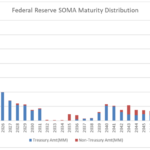September 2, 2022
Short and to the point. That’s how Chairman Powell’s annual speech was described. Not known for his brevity, and expected to speak for thirty minutes, the Chairman spoke for a little over eight minutes and the message was clear. Expect higher rates, for a longer period, potentially causing economic pain. With that, the idea of a Fed pivot was quickly removed from the markets and short and long term rates moved higher.
Looking at the CME Fed Watch Tool (Below) the market expects a 75 basis point increase to the overnight Fed Funds in at the September meeting, followed by another 50 basis points in November and 25 more in December. That should bring us to a range of 3.75%-4.00% to close out the year.
Yet despite all the rate increases, inflation reports, and Fed speak, the 3.19% yield to maturity (as of 10:00 am this morning) on the ten-year US Treasury remains below the 3.47% high on June 14th. Well below the 3.39% yield on the two-year US Treasury. Why is this? It seems counterintuitive to lend money for longer and get less return on it, right? The two-year responds to quickly to any changes in short term rates, be they overnight or 3 months. With an HP12c (Yes, I still use one) or a spreadsheet, you can quickly compound the other shorter rates and come up with what you can earn over two years and compare that to the yield on the two-year US Treasury. However, over longer periods, like ten-years, there are more cycles to consider, other risks and most importantly the value of your investment, when you get it back (i.e. Inflation).
Looking forward, we see three scenarios that could further bring down long term rates. The Fed is successful and slows the rate of inflation, the economy enters a recession, or volatility increases because of war or other fears. The scenario that long term rates don’t do so well? Despite the Fed’s best efforts or it’s just the new normal, inflation remains hot and continues above 2-3% for an extended period (i.e. The 70’s).
There is risk with extending out the curve. Indeed, in the short run we may be wrong and be heading for higher long-term rates, however, we think this risk is balanced by the risk of lower rates in the intermediate term. By accepting rate risk now, you lock in reasonable yields and perhaps avoid needing to take credit risk in the future if we re-enter the low inflation – low rate environment the Fed is seeking.
-Peter Baden, CFA
Chief Investment Officer
Click on the above links for more information on important investment and economic concepts.

Click on the above links for more information on important investment and economic concepts.
CME Fed Watch Tool
Contact Genoa Asset Management
William (Kip) Weese
SVP, Intermediary Sales
Northeast & South West
(508) 423-2269
Email Kip
Art Blackman
VP, Intermediary Sales
Central
(816) 688-8482
Email Art
Rick Bell
VP, Intermediary Sales
North Central & North West
(513) 762-3694
Email Rick
Disclosures
Indexes used for AAA Municipal Yields
2 Year: BVAL Municipal AAA Yield Curve (Callable) 2 Year (Symbol: CAAA02YR BVLI)
5 Year: BVAL Municipal AAA Yield Curve (Callable) 5 Year (Symbol: CAAA04YR BVLI)
10 Year: BVAL Municipal AAA Yield Curve (Callable) 10 Year (Symbol: CAAA10YR BVLI)
30 Year: BVAL Municipal AAA Yield Curve (Callable) 30 Year (Symbol: CAAA30YR BVLI)
Indexes used for US Treasury Yields
2 Year: US Generic Govt 2 Year Yield (Symbol: USGG2YR)
5 Year: US Generic Govt 5 Year Yield (Symbol: USGG5YR)
10 Year: US Generic Govt 10 Year Yield (Symbol: USGG10YR)
30 Year: US Generic Govt 30 Year Yield (Symbol: USGG30YR)
F/m Investments, LLC, doing business as Genoa Asset Management (Genoa), is an investment advisor registered under the Investment Advisers Act of 1940. Registration as an investment adviser does not imply any level of skill or training. The oral and written communications of an adviser provide you with information about which you determine to hire or retain an adviser. For more information please visit: https://adviserinfo.sec.gov/ and search our firm name. The opinions expressed herein are those of Genoa and may not come to pass. The material is current as of the date of this presentation and is subject to change at any time, based on market and other conditions. The information presented in the material is general in nature and is not designed to address your investment objectives, financial situation or particular needs. Prior to making any investment decision, you should assess, or seek advice from a professional regarding whether any particular transaction is relevant or appropriate to your individual circumstances. The information presented does not involve the rendering of personalized financial, legal or tax advice, but is limited to the dissemination of general information for educational purposes. Please consult financial, legal or tax professionals for specific information regarding your individual situation. This information does not constitute a solicitation or an offer to buy or sell any securities. Although taken from reliable sources, Genoa cannot guarantee the accuracy of the information received from third parties. Charts, diagrams, and graphs, by themselves, cannot be used to make investment decisions. Investing involves risk of loss, including loss of principal. Past performance is no guarantee of future results. An index is a portfolio of specific securities, the performance of which is often used as a benchmark in judging the relative performance of certain asset classes. Indexes are unmanaged portfolios and investors cannot invest directly in an index. An index does not charge management fees or brokerage expenses, and no such fees or expenses were deducted from the performance shown.



